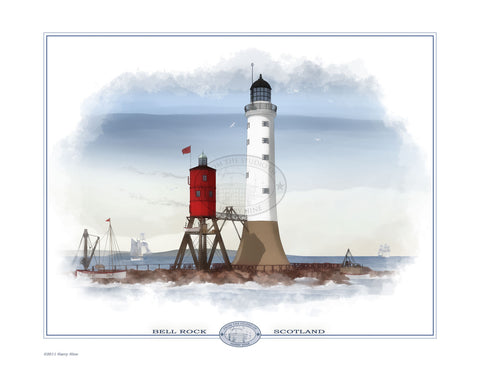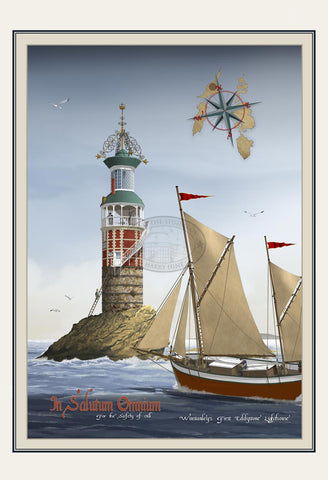Giclee print on fine art paper
Signed limited edition of 500 prints
Print dimension: 12" x 17"
After three years of extraordinary hardship and ingenuity, Henry Winstanley and his brave crew of craftsmen had accomplished what many claimed was impossible. They had built a lighthouse 14 miles out to sea perched atop a tiny wind and wave swept, sliver of rock.
In November 1698, Winstanley and his team left the lighthouse in the care of a keeper and his wife. The winter storms made it almost impossible to reach the lighthouse safely during the worst of the winter gales and so it was probably some months before the beleaguered keepers were relieved of their duty. They were only too happy to leave. It had been an appalling winter for them and one they wished never to experience again. Storms had blown for days on end causing the lighthouse to rock to and fro, only to be interrupted by the thunderous crash of a wave completely engulfing the tower. They told of the times that they had been literally thrown out of bed by the violence of the waves and because of the constant motion they had suffered from terrible seasickness for days on end.
The lighthouse after only one winter of operation was in terrible condition. The mortar holding the stones of the base together had been scoured away, solid beams and planking had cracked and splintered under the constant assault from the sea. Few of the window panes in the lantern were left intact.
Winstanley had repeatedly been told that it was impossible to build a lighthouse out on the Eddystone Rocks. These same detractors now picked up on the reported condition of the lighthouse and assumed that the tower would not survive to see another winter. Undaunted, Winstanley decided that what the Eddystone Rocks needed was a taller stronger and grander structure. He redesigned the entire building, hired back his brave team of craftsmen, and in short order set out to completely transform his storm damaged tower.
The first thing he did was to enlarge the stone base, from 24 ft in diameter to 40ft, and added another 8ft in height, Then he banded the base with thick iron hoops. A new much taller tower was then built around the old structure. Winstanley did not stop at simply improving the sturdiness of the building, he felt that his lighthouse should exemplify the exulted status of England to all who came within site and so added truly flamboyant embellishments. A flying platform was added to the side of the lantern, a huge and impractical weather vane topped the tower and on each face of the tower large engraved plaques were added.
With the living conditions greatly improved, a new keeper was hired in time for the next season of winter gales to descend upon the Eddystone Rocks and its lonely lighthouse. Even though the new tower was clearly a great improvement over the first, it must have been a feat of remarkable bravery to have accepted the post, when one reflects on the harrowing tales from the previous winter.
Winstanley was able to inspect his new tower early in 1700. He headed out from Plymouth in a brief respite from the frequent bad weather. He was delighted to find that his tower had faired quite well throughout the winter months, needing only minor repairs. Despite the increased height, the keepers told Winstanley that it was not unusual for waves to still completely engulf the tower. It certainly was not a comfortable place to be in bad weather!
Upon seeing Winstanley’s preparations to make the necessary repairs to the lighthouse, his detractors again commented that the tower would surely come crashing down given a few more large storms. Yet stood it did throughout the winters of 1701 and 1702, needing nothing more than basic maintenance.
November 1703 was a month of constant gales blowing in from the west. Shipping coming in from the Americas made record breaking crossings, being propelled by the unceasing winds. Ships started to crowd every port, harbor and estuary. Given the weather conditions mariners were happy to find safe anchorage and were in no hurry to leave.
Concerned for the welfare of his lighthouse during these gales, Winstanley made preparations to head out and make one final inspection before the worst of the winter storms hit. The gales had calmed by the morning of, 25th November 1703. Winstanley set out, ignoring the warnings from local fishermen and mariners that the calm would not last and that there was worse weather on its way. He was again met with gloomy predictions that his tower would not last through this seasons storms. In total exasperation Winstanley is quoted as saying that, “It is my crowning wish to be in my lighthouse during the greatest storm that ever blew under God’s heaven.”
And turn the weather did. Winstanley was able to land at the lighthouse, but because of the worsening conditions was unable to return to the ship which was forced to make for port without him. Winstanley should have been warned to be careful what he wished for. That night the greatest storm that ever was descended upon the British Isles leaving an island of ruin in its wake.
Reports of that harrowing night are well documented. The devastating winds toppled church steeples, tore tiles from roofs, flattened entire buildings, and live stock was drowned in the unbelievably high tide that accompanied the storm. Ships in the extremely over crowded ports started to break their moorings and smash into each other, pulverizing them to splinters. Thousands of sailors lost their lives being drowned within site of land.
By early morning the winds died down and as so often happens after a terrible storm, the clouds parted to reveal the true extent of devastation that stretched the length of Britain.
Standing on the hill high above the port city of Plymouth, survivors of that appalling night looked out to sea and realized that there was no longer a lighthouse resting atop the Eddystone Rocks. The only sign that there ever had been a tower perched upon the rust red reef were 12 twisted iron bars sticking out of the rock. Of Henry Winstanley there was no sign. He had been granted his wish and had been in his beloved lighthouse during the greatest storm that ever was.
The Eddystone Rocks had been the cause of many hundreds of shipwrecks, yet during the five short years Winstanley’s tower shone, a beacon high above the rocks, not one ship was lost. Ironically, two days after the destruction of the lighthouse an inbound ship from the Atlantic could not see the reassuring beam of light from the tower and tragically sailed into the teeth of the Eddystone reef and was lost with all hands.








